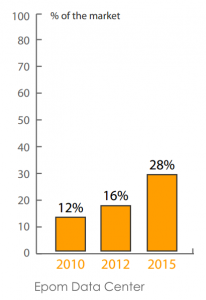'In-App Ads: New Realities & Maximised Profits', by Adam Jablonski, CEO of Epom
by Romany Reagan on 19th Nov 2012 in News


Ads Get into Apps, In-App Ads Get to the Top
It probably wouldn’t be an exaggeration to say that the modern user is almost 100% mobile, regarding both private time and work routine. Due to the fast pace of our lives, dynamics have already converted mobile into one of the key factors in development, no matter which industry is being discussed. Advertising is, obviously, even more affected by new mobility trends, which is perhaps why mobile ads in general, and in-app ads in particular, have recently become the new hit worldwide.
At the latest AppsWorld event, most discussions with experts ended with a similar conclusion: what we’re witnessing today is the incredible growth of the in-app ad sector. This tendency is apparently influenced by a multitude of factors, but without a doubt the major one is its colossal profitability potential.
Eastern European regions are developing the in-app sector at a relatively slower rate compared to other parts of the world (like the US, Canada or Western Europe, for example), however its commonly predicted growth is already palpable.
Tracking Users is the Key
However pessimistic some rookies might be yet, skilled developers have already acknowledged one important thing regarding the monetisation of their digital masterpieces: in-app ads appear to be the simplest, and at the same time the most effective, way to promote their brand and make a pretty good fortune. Here, no matter which exact region is being taken into account, versatile in-app advertising campaigns have already shown impressive results, likewise in the countries of Latin America and Eastern Europe, for instance.
In this respect, everything depends on the chosen strategy, of course, but in case you happen to own a paid app, either for iOS or Android, or any other popular mobile OS, you can increase your earnings from adding in-app ads to its lite version. Such separation will encourage fastidious users to purchase the paid version, on the one hand, whereas others will go with the free version, where they will be displayed numerous ads. You will earn both ways.
Nonetheless, it’s worth pointing out one possible hurdle on your way to success -- tracking the number of apps installs, which might become a really complicated thing to do. Fortunately, even with no direct access to Google Play and App Store servers, this won’t become an issue if you’re working with the proper ad serving platform. Namely, we’ve already implemented brand-new relative technologies at Epom that help you track the installs of your application in a fast and convenient way and, thus, optimise your running ad campaigns to a considerable extent. Epom technology enables clients to tracks app installs from Google Play and App Store via unique app tracking SDK’s for iOS and Android, even though the direct access to such statistics isn’t usually provided.
The applied technology, commonly known as device fingerprinting, works in the following way: as soon as the ad is clicked on, Epom records and stores the info about the click, including the special device identifier. Further on, the user, who has clicked on the ad, installs the app that was advertised (via Epom App Tracker SDK for one of the mobile OS’s, for instance). As soon as this particular app is launched for the first time, the generated notification, regarding the installation, is sent to the Epom ad server with the identifier. If the identifier matches the previously logged device fingerprint from the ad click, the server records it as conversion.
What to Expect?
No matter how essential in-app ads have already become for developers wishing to monetise their applications, prospects for the future remain even more exciting. Not only have the mighty rivals in the market added a great deal of innovative features, but the ads themselves are currently getting more attractive for users to respond to. In particular, fresh Google technology enables us to install apps on users’ mobile devices automatically, as long as one’s smartphone or tablet gets online, depending on what a person previously intended to install from Google Play on the display browser. It opens up immeasurable opportunities in terms of advertising apps in display, with the same effectiveness and at a much lower cost, as display advertising is generally cheaper in all areas and regions. This tendency will most likely prevail in the future for a long period of time.

As for the improvement of ad interactivity and effectiveness, rich media will continuously get more and more popular, though the saturation of use, according to Epom Data Center, turns out differently in various parts of the world. In particular, whereas the largest number of rich media in-app ads is seen in America, more standard banners are still being applied in Asia and Eastern European countries. In particular, in the latter case, the percentage of rich media ads has only reached 9% of the market, for now. Nonetheless, their share of the market is likely to increase in the upcoming years, so the region will be worthy of working with.
DisplayDSPEMEAMobileProgrammaticSSP









Follow ExchangeWire